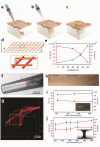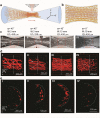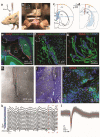Syringe-injectable electronics
- PMID: 26053995
- PMCID: PMC4591029
- DOI: 10.1038/nnano.2015.115
Syringe-injectable electronics
Abstract
Seamless and minimally invasive three-dimensional interpenetration of electronics within artificial or natural structures could allow for continuous monitoring and manipulation of their properties. Flexible electronics provide a means for conforming electronics to non-planar surfaces, yet targeted delivery of flexible electronics to internal regions remains difficult. Here, we overcome this challenge by demonstrating the syringe injection (and subsequent unfolding) of sub-micrometre-thick, centimetre-scale macroporous mesh electronics through needles with a diameter as small as 100 μm. Our results show that electronic components can be injected into man-made and biological cavities, as well as dense gels and tissue, with >90% device yield. We demonstrate several applications of syringe-injectable electronics as a general approach for interpenetrating flexible electronics with three-dimensional structures, including (1) monitoring internal mechanical strains in polymer cavities, (2) tight integration and low chronic immunoreactivity with several distinct regions of the brain, and (3) in vivo multiplexed neural recording. Moreover, syringe injection enables the delivery of flexible electronics through a rigid shell, the delivery of large-volume flexible electronics that can fill internal cavities, and co-injection of electronics with other materials into host structures, opening up unique applications for flexible electronics.
Figures




Comment in
-
Bioelectronics: Injection and unfolding.Nat Nanotechnol. 2015 Jul;10(7):570-1. doi: 10.1038/nnano.2015.129. Epub 2015 Jun 8. Nat Nanotechnol. 2015. PMID: 26053996 No abstract available.
-
Injectable meshes for neural recordings.Nat Methods. 2015 Aug;12(8):702-3. doi: 10.1038/nmeth.3511. Nat Methods. 2015. PMID: 26451423 No abstract available.
-
The Future of Neural Recording Devices: Nanoscale, Flexible, and Injectable.Neurosurgery. 2015 Dec;77(6):N17-9. doi: 10.1227/01.neu.0000473810.83726.bc. Neurosurgery. 2015. PMID: 26584322 No abstract available.
References
-
- Kaltenbrunner M, et al. An ultra-lightweight design for imperceptible plastic electronics. Nature. 2013;499:458–463. - PubMed
-
- Kim D, et al. Epidermal electronics. Science. 2011;333:838–843. - PubMed
-
- Wang C, et al. User-interactive electronic skin for instantaneous pressure visualization. Nature Mater. 2013;12:899–904. - PubMed
-
- Tee BCK, Wang C, Allen R, Bao Z. An electrically and mechanically self-healing composite with pressure- and flexion-sensitive properties for electronic skin applications. Nature Nanotech. 2012;7:825–832. - PubMed
Publication types
MeSH terms
Grants and funding
LinkOut - more resources
Full Text Sources
Other Literature Sources

